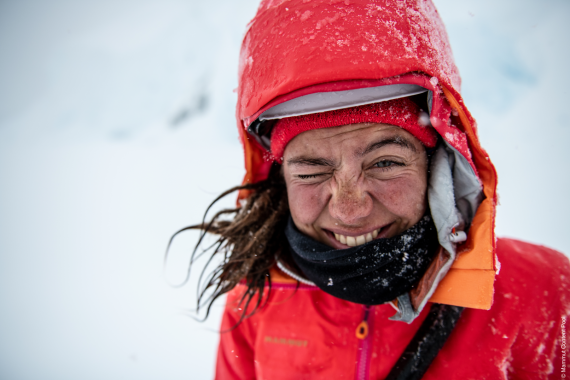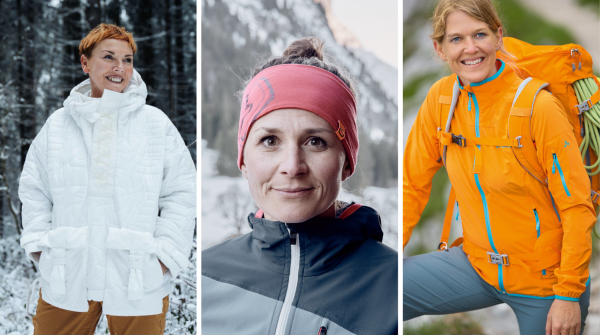Somewhere in a granite wall in Greenland. Three climbers stand on a narrow ledge, tired, exhausted. At their feet, the drop is hundreds of meters. Above their heads, the rock is lost in the distance. And: Time is running mercilessly against them. They have only a tiny window of time left before an impending snowstorm forces them to turn back. They have to make a decision. Just enjoy the climbing a little longer and then rappel? Or rest and gather strength in the vague hope of actually making it to the exit the next day? How should the expedition that took two years of planning end? That welded the entire team together on a sailboat for six weeks to get them to this point?
One of the three climbers is Caro North. The mountain guide is one of the most renowned alpinists in Europe. At the age of 16, she climbed the almost 7,000-meter-high Aconcagua in the Argentine Andes. First ascents in Armenia and Iran followed. Her breakthrough on the scene came in 2015 at the latest, when she reached the summit of Cerro Torre together with Christina Huber. It is the first free ascent of the iconic granite mountain by an all-female rope team.
Several difficult routes and strenuous expeditions later, Caro wants to fulfill a dream. The adventurer is drawn to Greenland, which with its imposing walls is one of the most exciting destinations for big wall enthusiasts, for a first ascent. She would like to sail from France to the promised climbing country on the other side of the Arctic Circle. More environmentally friendly than traveling by plane - more exciting anyway. "At sea, you're even more secluded than almost anywhere in the mountains," says Caro in the Bergfreunde podcast "GRAT RAUS".
It's a long way from the idea to implementation. The entire expedition is expected to take three months. Sponsors have to be convinced, team members acquired. The search for a suitable expedition boat also proves difficult. The choice falls on the 15-meter Northabout. And the expedition group is finally in place: eight women, four of them sailors, three alpinists, one photographer - each with different strengths.
The starting point of the journey is the traditional port town of La Rochelle. The route continues via Iceland to the east coast of Greenland. Where exactly? Ultimately, the winds will have to decide. At the beginning, the winds are anything but kind to the expedition.
On the very first leg, the Northabout is caught in a violent storm. Mighty waves slap against the ship's side, hurl the boat upward, then drop it again. The wind tears ceaselessly at the reefed sails. After just five days, the group makes an involuntary stop in Dublin. A week passes before the journey continues.
"Being stuck on a 15-meter boat with eight people in bad weather is tough," Caro admits. The alpinists' biggest challenge: When they're not climbing, their performance goes downhill. With an endurance training plan and a grip board brought along, the loss of level should actually be prevented. However, effective training is only possible when the sea is calm.
Then, on the Faroe Islands, the group has serious doubts. Another storm, another forced break, this time for ten days. After a round of jogging in the cold and wet, the question arises whether the women will reach Greenland at all. After all, they have to make the return trip before the September storms in the North Atlantic. Due to the delays, the time for climbing has already massively dwindled. A detour to Norway could offer a way out. But the team is sticking to its original plan. A good decision? Once they arrive in Iceland, bad weather once again condemns the expedition members to doing nothing.
For six weeks, low-pressure systems put the group's ability to suffer to the test. But then comes the moment that makes up for a lot. "When we saw the coast, it was amazing, a huge moment," says Caro, looking back on her arrival in Greenland. But something clouds the joy. Scoresbysund, the site of the longed-for granite walls, is closed off by pack ice. A paragliding flight from a small peak can at least sweeten the waiting time a little.
Shortly thereafter, the Northabout sets sail again. From the mast, one crew member at a time navigates through the icy labyrinth at the entrance to the fjord, past floating ice blocks, ice floes, and massive icebergs, of which only the tip protrudes from the water. Finally, the alpinists go ashore. From now on, a race against the clock begins. While the hours on the boat still drag on like chewing gum, they now literally race away from the women.
For three and a half days, they transport material from the base camp on the beach to the foot of the chosen granite wall, which towers more than 700 meters above them. A glacial fracture with bizarre crevasses makes progress difficult. Nevertheless, the rock of the wall seems to be good. When favorable weather announces itself, the three women begin the ascent. They take only the most necessary equipment with them. Any additional weight would only slow them down.
The start is promising. Then, however, the wall becomes steeper and progress is slow on the partially wet rock. Every meter requires full concentration. On the second day, after an eternity in the climbing harness, the women reach a band. Time to catch their breath. And for the trend-setting decision. They agree to spend the night at dizzying heights and the next day to do everything they can to get to the exit.
The morning greets them with a cold sea of fog that envelops the landscape below them - and stokes concerns about bad weather. Hastily, the team climbs off. "The first pitch was still challenging, then it got easier," Caro recalls. And suddenly it's as if she's flipped a switch. "When we step on the gas, we get 60 meters higher with each length, which goes relatively quickly." The others get carried away. What seemed impossible a short time ago is now taking on more and more concrete form.
And is suddenly a reality: At twelve o'clock on the dot, the three women get out of the east wall of the Northern Sun Spire. "That was the most jaw-dropping moment," Caro describes. "When you've put in that much time, a first ascent is just worth so much. When you've sailed there for six weeks, trained for it a year before, and we actually didn't believe in it anymore. That was insane." Since then, the route has been called "Via Sedna," just like the entire project. The composition of the name - "Via" as the Italian word for path, "Sedna" as the Greenlandic goddess of the sea - illustrates the combination of sailing and climbing.
The alpinists cannot savor their triumph for long. They abseil down, transport their material to the beach, meet the sailors, set sail. If they had hoped that the journey home would be more favorable than the outward journey, they are deceived. Sedna, or whatever deity watches over the oceans, will not be appeased by the group's performance so far. With furious storms, she tests the strength and will of the women one last time. They persevere - and finally reach France.
How do you survive such hardships? How do you manage to face the next challenge right after every obstacle you've overcome? "Extremely great motivation can make up for an extreme amount," Caro says in regards to the first ascent. "We knew we only had this small amount of time, we had to give it our all now."
A key to success throughout the weeks is community. "It works well when you can fully trust each other, when you can also communicate openly," Caro finds. This also includes giving the others space and leaving them alone when things aren't going so well. Or developing a sense of when someone needs cheering up.
The women's team puts a certain amount of pressure on itself to bring the expedition to a successful conclusion. "It's actually a shame, but because the world of expedition sailing and expedition mountaineering is so male-dominated, we really wanted to prove that we could do it," says Caro. Perhaps that's what makes the members defy all odds to the very end.

Caro hopes to inspire and motivate other women with the Via Sedna project. "Out of the whole team, I am the only one who is a professional athlete. Everyone else has normal jobs and has taken unpaid leave. And we still went through with it. I believe that if you have dreams, you should give everything to them. Then you can make them happen." Even if the way there leads over seas and a 780-meter-high granite wall.

 Promotion8 Tips for Autumn in South Tyrol
Promotion8 Tips for Autumn in South Tyrol
- Awards
- Mountain sports
- Bike
- Fitness
- Health
- ISPO Munich
- Running
- Brands
- Sustainability
- Olympia
- OutDoor
- Promotion
- Sports Business
- Textrends
- Triathlon
- Water sports
- Winter sports
- eSports
- SportsTech
- OutDoor by ISPO
- Heroes
- Transformation
- Sport Fashion
- Urban Culture
- Challenges of a CEO
- Trade fairs
- Sports
- Find the Balance
- Product reviews
- Newsletter Exclusive Area
- Magazine






